Oslo Gardermoen Airport seeks Asian flights to leverage tourism to Norway; perhaps the new Iceland
Oslo Gardermoen Airport has sat out the recent boom in Asian growth. This is not just in comparison to neighbouring Helsinki's rapid Asian growth in tandem with Finnair, but even more broadly. Norway is the largest Western European country without a flight to China, and is the smallest of Western European countries with flights to Asia. Its only destination is Bangkok.
This is a juxtaposition to Norway's strong credentials: maritime and gas businesses, a wealthy population (much more so than Finland's) for outbound travel, and untapped year-round tourism opportunity - not just for Oslo but for all of Norway, from fjords in the summer to northern lights in the winter.
New management at Oslo airport wants to regain the initiative in Asia. Norway has the credentials to follow Iceland's sudden rise in tourism, especially from China. Management is considering foreign airlines, since SAS is in low-growth mode and has historically favoured Copenhagen, and Norwegian Air Shuttle lacks US approval for the NAI license it seeks - but perhaps more importantly is unable to access Russian overflight rights.
Oslo seeks to regain the initiative in Asia
Oslo Gardermoen Airport has the unfortunate distinction of being Western Europe's largest market without a flight to China. Oslo is also last among Western European airports with flights to Asia. Oslo airport's new management wants to end this. Management at Avinor changed earlier in 2016 and new personnel have come in, with a more typical proactive approach to airline marketing and tourism partnerships; previously there was limited interest in route development at Oslo.
Changing mindsets with stakeholders and airlines takes time. Yet Oslo's only links to Asia in Oct-2016 are a five times weekly service to Bangkok from Thai Airways and twice weekly to Bangkok from Norwegian Air Shuttle (the frequency increases during northern winter). So there are untapped opportunities.
Of the four main Scandinavian/Northern European hubs - Copenhagen, Helsinki, Oslo and Stockholm - Helsinki started the past decade with the largest number of Asian destinations and has considerably grown since 2011, in tandem with Finnair's expansion.
Northeast and Southeast Asian destinations by year launched at Scandinavian/Northern European hubs: 2007-2016
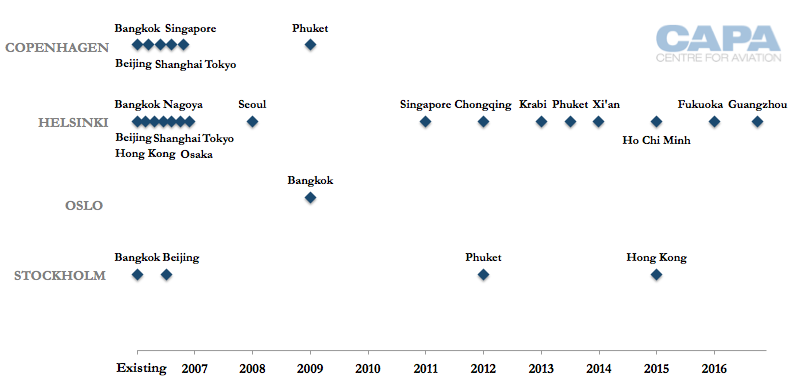
Foreign airlines, not SAS or Norwegian, are Oslo's target for Asian growth
Despite the goals for Asian growth, the larger expansion opportunity for Oslo is in the North American market. While Oslo would like to see North American carriers enter Oslo, Norwegian Air Shuttle's growth has been large, and provoked a growth response from SAS.
Oslo Gardermoen Airport to North America (seats per week, one way): 19-Sep-2011 to 13-Mar-2017
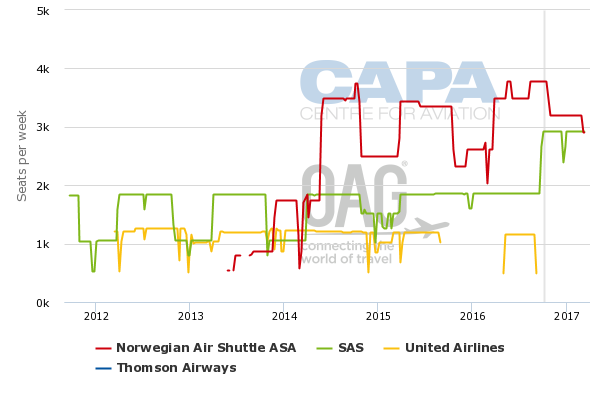
To Asia, Oslo's vehicles for growth will be different. Norwegian Air Shuttle would seem the prized target and Norwegian would very much like to grow in Asia.
Norwegian, however, is held back by two factors. First is its inability to secure more Russian overflight rights - a murky scenario likely involving Russian politics and SAS has no interest in seeing Norwegian grow.
Second is Norwegian's inability to secure approval from the US DOT for Norwegian Air International, which would enable all long haul flights to be operated under an Irish AOC that permits more favourable Asian traffic rights than a Norwegian AOC permits. The US is not directly relevant so far as traffic rights are concerned, since Norway was an extra party to US-EU open skies. Even without a licence for NAI, Norwegian would like to grow Asian services under its Norwegian licence but is held back by the lack of Russian overflight rights.
Traditional flag carrier SAS was once the original Nordic-Asia leader, but weighed down under a high cost base that it has been unable to arrest, SAS has essentially become a boutique airline. Airports do not consider SAS to be a high-growth airline.
Of SAS' 101 weekly long haul flights from Scandinavia in Oct-2016, the majority - 63% - originate from Copenhagen. Stockholm is the base for 26%, and Oslo the remaining 11%. All of SAS' Oslo long haul flights are to North America (Miami and Newark).
SAS weekly long haul flights by departure hub: 3-Oct-2016 to 9-Oct-2016
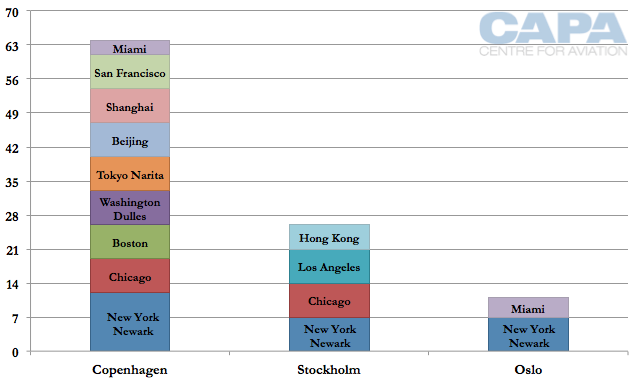
See related reports:
Oslo is Star Alliance territory but has a variety of local demand
An airport that is a strong hub for an alliance can deter airlines from other alliances. At Oslo 46% of seat capacity is aligned with Star while 49% is unaligned, largely reflecting the presence of Norwegian Air Shuttle.
For domestic there is an almost even split between Star and unaligned, while 43% of the international capacity is made up of seats flown by Star; 47% is unaligned, and then approximately 5% for each of oneworld and SkyTeam.
Oslo Gardermoen Airport system capacity share by alliance (3-Oct-2016 to 9-Oct-2016)
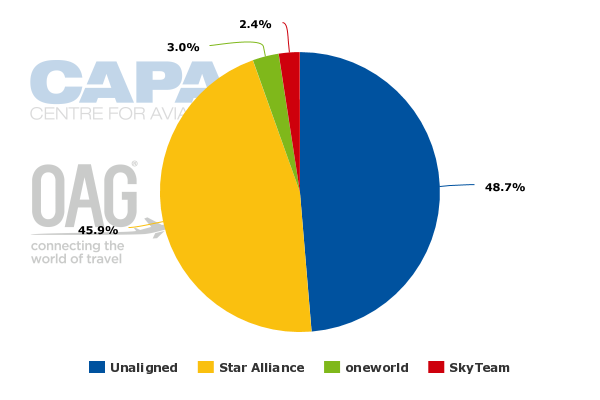
For airlines not a member of Star, or unable to partner with SAS, Oslo's view is that lack of beyond feed will not be as big a challenge as in other markets, and especially competing ones like Helsinki, which has cemented itself as the Northern European gateway to Asia. Norwegian is one of many LCCs exploring the opportunity to transfer passengers to/from other airlines.
This medium-term development, if realised, could provide an alternative for beyond market access.
Oslo's strengths have not been previously leveraged. Oslo has both leisure and corporate opportunity that is both inbound and outbound. Oslo is the gateway to Norway, whose population is, statistically, one of the wealthiest in the world and has an income twice as high (USD100,000) as in Finland (USD50,000).
Finland and Norway have similar populations (5 million) and the outbound Finnish market has helped Finnair's expansion, although outbound Finland demand for Finnair is still relatively small.
Finnair Helsinki stopover ad: 2016

Inbound Finland demand has not been strong, although Finnair is trying to bolster this with its introduction earlier in 2016 of a free stopover in Helsinki. This still positions Finland as a transit hub and not end destination.
Oslo Airport believes there is opportunity for Norway's larger tourism industry to bolster its marketing as a year-round destination offering snow and northern lights in the winter and then fjords in the summer.
This is not dissimilar to the principle of Iceland's tourism, although that also includes volcanoes and thermal pools. Norway is already starting to promote itself in Asia as a destination for high-quality, fresh fish, especially salmon. Although not the highest-yielding cargo, it is in year-round demand, providing consistent freight.
Oslo Airport also foresees opportunities to position Norway as a market with many destinations, whereas Denmark and Sweden tend to fall back on singularly promoting their largest cities. Oslo believes that Asian visitors who do a tour around Scandinavia typically spend the most time by far in Norway, yet do not use Norway as their entry/departure points due to the lack of nonstop Asian flights to Northeast Asia and limited offering to Southeast Asia.
Chinese tourism to Iceland has grown rapidly and in 2015 there were on average 131 Chinese visitors, despite the lack of nonstop flights. China was Iceland's seventh largest market, with as many Chinese visiting as Canadians. The only other identified Asian source market for Iceland was Japan, which in 2015 had only 45 daily visitors to Iceland (on average).
Oslo expects nonstop flights to Asia to be more sustainable for airlines given the shorter distance (an A330 can reach Oslo from most of Northeast Asia) and business demand. Oslo has a large oil and gas sector (even if it has weakened with the collapse in oil prices) as well as maritime industry,
Annual Chinese and Japanese visitors to Iceland: 2010-2015
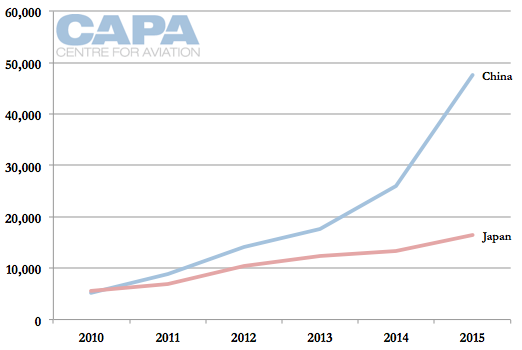
Norway is the largest European market without a Chinese flight
There are many ways to rank European countries with regard to their magnitude of aviation presence.
One metric might be total seats to, from and within the country. On this basis, Norway is the largest European market without a Chinese service. Right behind it is Portugal - although it appears that Hainan Airlines may open a service to Lisbon to link with its new strategic and equity partner Azul. Portugal has also become a popular market for Chinese home ownership, which grants Portuguese citizenship and thus - an EU passport.
Of Norway's immediate competitors, Sweden has (broadly) one daily Chinese flight, Denmark two and Finland three. In the peak summer Finland's figures are larger due to seasonal, summer-only flights.
Slightly larger than Norway is Greece, which has a Chinese service (from Air China), but this is served as a tag in both directions from Munich and is not nonstop. A bit smaller than Norway is Ireland, which also has no Chinese - or Asian - service but is likely to receive a Chinese flight in the near future.
Average daily nonstop flights from European countries to mainland China and all of Northeast/Southeast Asia: 2016
| Europe-Mainland China | Europe-Northeast/Southeast Asia (including China) |
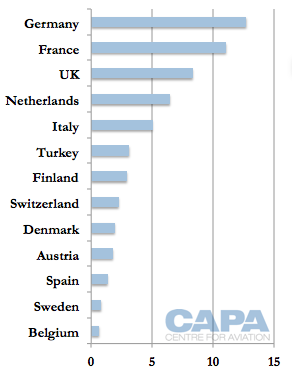 |
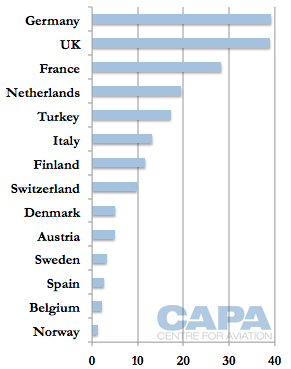 |
Oslo identifies the greater Chinese cities of Hong Kong, Shanghai and Beijing as its second, third and fourth largest unserved markets, respectively. Some of Oslo's new management used to be at Copenhagen airport and had liaisons with the HNA Group, whose Beijing Capital Airlines conducted charters in 2015.
Oslo Airport considers the HNA Group airlines to be initially more suitable, since they are more agile than state-owned Chinese airlines and have experience working very closely with Chinese tourism agencies to fill flights (sometimes essentially as charters).
As always with China, however, booking data comes with the limitation that the high growth out of China means new markets can be established once flights are put in (often with generous subsidies).
Singapore is the largest unserved market from Oslo, but SIA is unlikely to cannibalise Copenhagen
While greater China tops the list of Oslo's unserved markets, the greatest opportunity is Singapore. It appears unlikely to be served. Singapore Airlines serves Copenhagen nonstop five times a week with the 777-200ER.
Oslo and Norway are typically the largest behind markets for SIA's flight. There are approximately 2,000 Norwegians in Singapore and the two countries are linked through maritime and oil/resource industries. Singapore Airlines is not considering serving Copenhagen and Oslo a few times a week for each city, but rather intends to move Copenhagen to a daily A350-900 service.
The SIA LCC subsidiary Scoot is launching European services (first to Athens, which SIA exited), but Scoot flights to Oslo may cannibalise SIA's Copenhagen service. SIA's service to Copenhagen makes Denmark one of its smallest European points, but for now SIA intends to remain in the market rather than hand it to Scoot. SIA and SAS have a JV on the route, although SAS does not fly to Singapore (limiting the usefulness of the JV).
See related report: Scoot selects Athens as first route in Europe; head to head against intense Gulf competition
Singapore Airlines top 10 European countries ranked on available seat capacity: 3-Oct-2016 to 9-Oct-2016
.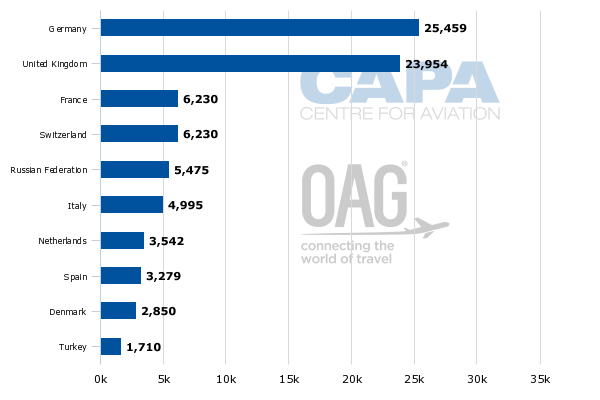
Thai Airways provides Southeast Asian access to Oslo
Thai Airways (for now) provides connections from Oslo across Southeast Asia. Its Bangkok hub is more suitably located geographically (Singapore is further south), but Thai Airways has a far smaller Southeast Asian network than Singapore Airlines.
Of Southeast Asia's other flag airlines - Garuda, Malaysia Airlines, Philippine Airlines and Vietnam Airlines - none are likely targets, due to market mismatch or the airline pulling down growth (Malaysia). Bangkok is naturally a popular outbound leisure destination from Oslo - more so than other Southeast Asian points.
Most long haul LCCs are based in Southeast Asia, but Oslo is concerned their growth into Norway could jeopardise Thai Airways' service.
See related reports:
- Thai Airways 2016 Outlook: regional growth & focus on revenue management. Profitability a challenge
- Thai Airways regional connectivity Pt 2: Thai Smile international expansion is a strategic necessity
Besides European airlines that connect Oslo to Asia via other hubs, Gulf airlines' Oslo flights largely cater to the Southeast Asia market. Emirates serves Oslo with upwards of a daily 777-300ER while Qatar has a daily 787-8.
Oslo service from Japan is unlikely while Korea could be a near opportunity
Tokyo is the fifth largest unserved Asian market from Oslo, but a service seems unlikely to eventuate. All Nippon Airways has historically had weak ties with SAS, and ANA is unlikely to pursue Oslo without beyond connections. ANA also has a tight and expansive JV with the Lufthansa Group, which has Northern Europe as part of its catchment area for Frankfurt.
Japan Airlines is unlikely to serve Oslo since it already serves Helsinki in cooperation (initially codeshare and now JV) with fellow oneworld partner Finnair. From Helsinki JAL can access Finnair connections to Oslo and across Norway.
From Korea it is more likely that Korean Air - and not Star member Asiana - could serve Oslo. Asiana is far smaller than Korean Air and has tended to follow Korean Air, rather than develop new markets to differentiate itself from Korean Air. Korean Air has some familiarity with Oslo, having run charters. Korean Air may first look to tag Oslo with another European point.
Outlook: balancing Asian airline growth while preserving opportunities for Norwegian
With only one Asian destination, and not a Chinese one at that, Oslo Airport and broader Norwegian tourism have clearly missed opportunities over the years. New management is right to regain the initiative, although they do so in a more crowded space than previously.
With SAS largely absent from Oslo and Norwegian unable to grow to Asia, Oslo may appear to have the straightforward task of seeking foreign airlines. Inevitably Norwegian will one day be able to grow to Asia, and Oslo will want to ensure there are opportunities for it.
It is a balance to preserve long-term opportunities while fulfilling medium-term needs.
With long haul North American bases around Scandinavia and a growing number of other European points, Norwegian has much leverage to move growth. Should Norway succeed with strong tourism and capitalise on the apparent potential it sits on, this is complementary for its namesake airline.